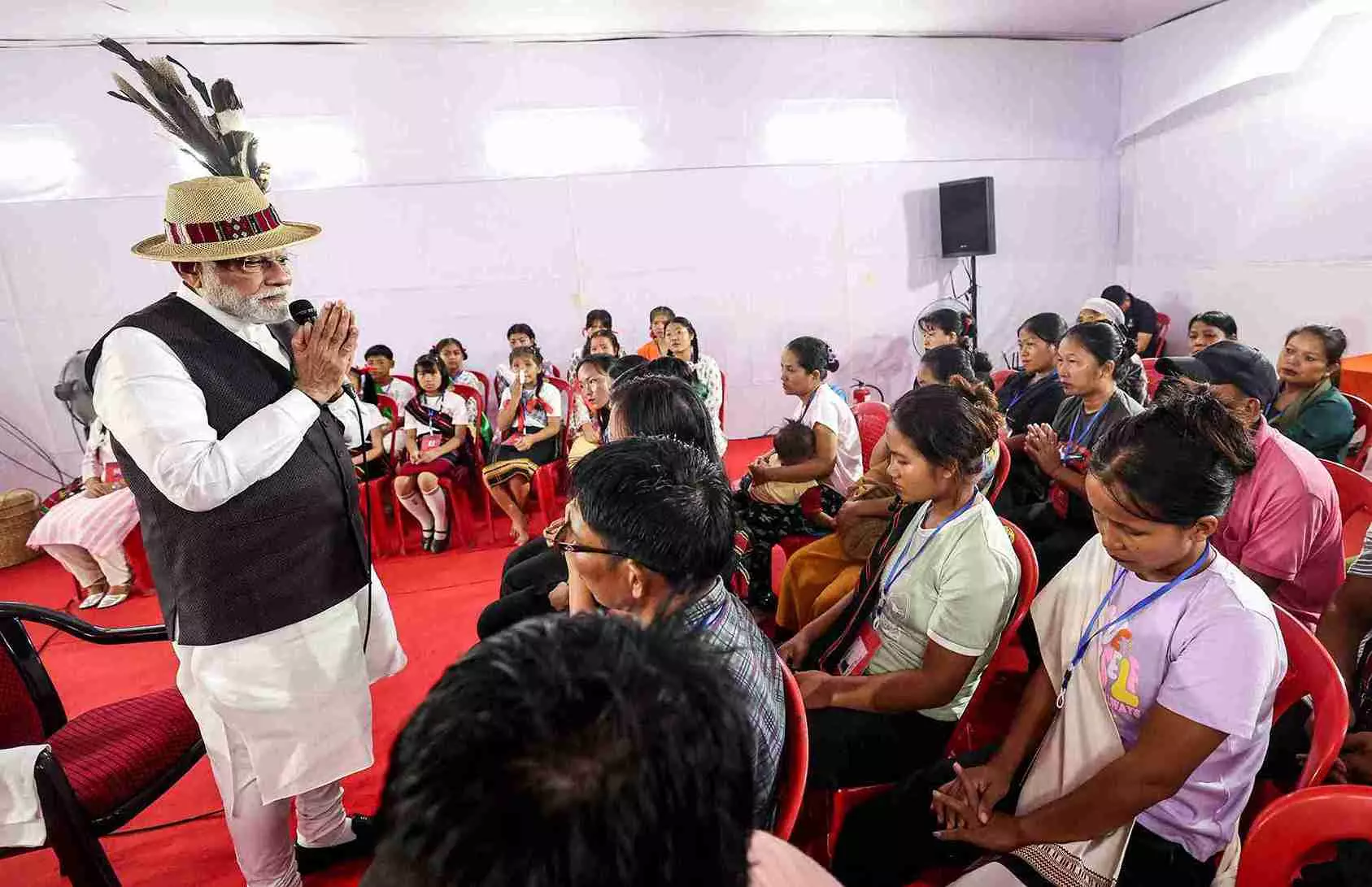
Modi’s projects offer little solace to thousands in Manipur’s relief camps
While PM Modi’s Manipur visit was rich in symbolism and a spectacle extraordinaire, it left most of the strife-torn state’s most pressing questions unanswered

In a high-profile visit to Manipur on Saturday (September 13), Prime Minister Narendra Modi inaugurated and laid foundation stones for development projects valued at over Rs 8,500 crore across Imphal and Churachandpur.
While the Prime Minister emphasized themes of “peace and stability” in his public addresses, he conspicuously avoided referencing the state’s ongoing ethnic tensions, the humanitarian challenges faced by internally displaced persons (IDPs), or the broader political impasse that continues to affect governance in the region.
No mention of state’s challenges
This marked Modi’s first visit to Manipur since ethnic violence erupted on May 3, 2023—a conflict that has claimed more than 200 lives and displaced nearly 60,000 people.
Despite the gravity of the situation, his speeches did not include direct mention of the Meitei or Kuki-Zo communities, whose strained relations lie at the heart of the crisis. Nor was there any articulation of a roadmap for the safe and dignified return of IDPs to their original homes.
The absence of any commentary on the humanitarian conditions in relief camps and the ongoing Governor-led administration—following the imposition of President’s Rule in February 2025—was conspicuous.
Observers noted that while the prime minister spoke at length about regional development, the silence on the state’s internal challenges was striking.
Also read: Road and infotech projects, Ima markets: What Modi launched, pledged in Manipur today
Was it all stage-managed?
The Imphal event drew significant attendance, though questions were raised about the nature of the turnout.
According to multiple sources who requested anonymity, government employees across departments were reportedly instructed to attend the prime minister’s functions without exception. This directive, they suggested, created a curated atmosphere of support that may not reflect the underlying public sentiment.
“Everything is stage-managed except for the weather,” remarked one attendee who was not happy with the fact that the prime minister did not say a word on the ongoing conflict. Adding to the complexity, the prime minister used the occasion to ironically comment on political developments in Nepal, congratulating former Nepal Chief Justice Sushila Karki on her appointment as the first woman interim prime minister of the Himalayan country.
While the gesture was diplomatically significant, it stood in contrast to the lack of engagement with Manipur’s own political deadlock and the intricacies created by the absence or the installation of a democratically elected government.
Also read: PM Modi attends Hazarika birth centenary event in Assam after Manipur visit
Project list amid political uncertainty
The core of the prime minister’s addresses in both Imphal and Churachandpur was a detailed listing of infrastructure projects aimed at overcoming the state’s historical connectivity challenges and boosting its economic potential.
In Churachandpur, Modi laid the foundation stone for projects worth over Rs 7,300 crore. These included projects worth over Rs 3,600 crore to revamp urban infrastructure such as roads and drainage, five national highway projects collectively valued at over Rs 2,500 crore, the Manipur Infotech Development (MIND) project, and Working Women’s Hostels at nine locations.
Modi highlighted a multi-level approach to connectivity, stating that the budget for rail and road infrastructure had been “increased manifold” since 2014. He underscored that Rs 3,700 crore had already been spent on national highways in the region, with new projects worth Rs 8,700 crore progressing rapidly.
A flagship project is the Rs 22,000 crore Jiribam-Imphal railway line, which promises to connect the state capital to the national rail network. He also cited the new Rs 400-crore Imphal Airport and new helicopter services as evidence of improved air connectivity.
Also read: PM Modi’s visit to Manipur comes amid a minefield of challenges
Playing the development card
In Imphal, he inaugurated projects worth over Rs 1,200 crore, focusing on governance and technology: A new Civil Secretariat building at Mantripukhri, the first building of the IT Special Economic Zone (SEZ), a new state police headquarters, Manipur Bhavans in Delhi and Kolkata to provide affordable accommodation for citizens, and four new Ima Markets (all-women markets) across districts.
Modi envisioned Imphal as a future-developed city and a hub for startups and tech-based industries, powered by the new IT SEZ. Beyond hard infrastructure, the prime minister extensively listed central government welfare schemes, claiming significant gains for Manipur: Housing, electricity, tap water connections, healthcare, tribal development, etc.
Also read: Is Manipur back to 'normal' ahead of PM Modi's visit?
Normalcy narrative vs ground realities
Civil society actors and local activists interpreted the visit as a strategic effort to project normalcy and forward momentum rather than a genuine attempt to engage with the complexities of the much-needed reconciliation.
“The visit was designed to showcase development, not to engage with the messy, complex politics of the ethnic conflict,” said one Imphal-based activist. “By not naming the communities or addressing the core political issues, the PM is effectively sidestepping accountability for the central government’s role in managing the crisis.”
For the thousands residing in relief camps, the announcements of new infrastructure offered little solace. The demand for a comprehensive political solution, justice, and a secure return home remains unmet. As such, while the prime minister’s visit was rich in symbolism and a spectacle extraordinaire, it left many of Manipur’s most pressing questions unanswered.

